Advances in the Applications of Lasers for Bioimaging: Light Sheet Microscopy
Spectroscopy
Lasers allow advances for investigation of biological samples. Discussed here are some of the most interesting recent developments in light sheet microscopy for bioimaging, including a technique that allows for unique viewing of large, intact samples including biopsies.
The use of laser light for investigation of biological samples is continuing to advance rapidly. Here, we briefly discuss some of the most interesting recent developments in light sheet microscopy. New methods allow for large, intact samples to be measured, as miniature designs, modular systems, and optical clearing techniques are allowing new, unique views into samples and biopsies.
Spectral imaging is valuable in applications from industrial controls to agronomy. Perhaps nowhere is there more exciting and new application of spectral imaging than in biology and medicine. Problems range from in vivo and in vitro studies of living organisms, to developmental studies of whole organisms and of sampled tissue. Pathology is rapidly adopting experimental methods, including laser excitation.
For high-resolution images, confocal microscopy is the gold standard. A simple schematic representation of confocal microscopy is shown in Figure 1. Because the light source and the detector are spatially focused, with apertures blocking out-of-focus light, confocal microscopy can yield very high spatial resolution information. However, this information comes at a cost-getting information about the entire sample requires time-consuming scanning of the focal volume through the entire volume of the sample. Although there are numerous, continually improving methods for speeding up the information transfer, when focal volumes are small, it is still common for a moderate-sized volume to take 12-18 h to scan.
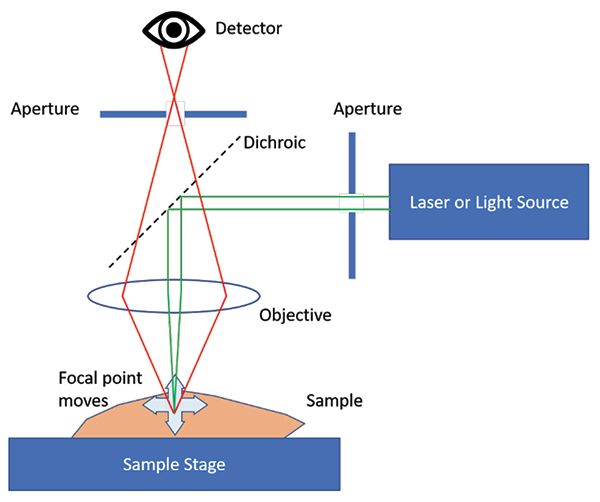
Figure 1: A simple schematic representation of a confocal microscope.
To speed up data transfer, a logical thought would be to illuminate a plane of the sample and to detect orthogonally to the illuminated plane with an imaging device. This takes the single-point detection method of confocal microscopy and translates it into a many (illuminated) to many (detected) method. So-called "light sheet microscopy" has been around in concept for a century or more, but it took the advent of lasers and digital imagers to make it practical.
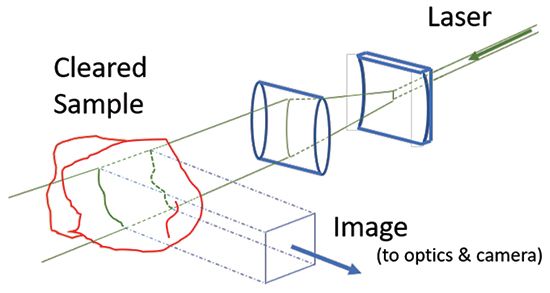
Figure 2: A simple schematic representation of a light sheet microscope, in which a laser beam is formed into a thin sheet to intersect a cleared sample. The image is extracted orthogonally to the plane of the light sheet.
Figure 2 shows a simple schematic representation of a light sheet microscope (LSM). Commercial versions of LSMs have been available for some time, most notably the Zeiss Lightsheet Z.1 and the Luxendo (now owned by Bruker) series of selective plane illumination microscope (SPIM) systems. These advanced systems have proven successful for measurements of many types of biological samples. Figure 3 shows an image of first cell division in a mammalian zygote, using the system that was the precursor of the Luxendo InVi SPIM at the European Molecular Biology Laboratory (Luxendo is a spin-out of that laboratory). This image, taken from a mouse embryo, shows the formation of two spindles during the cell division and replication, and indicates that male and female genetic material is still separated. This publication in 2018 overturned the then current understanding, and was subsequently published in Science (1).
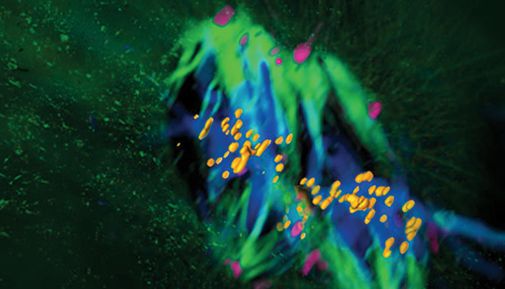
Figure 3: An illustration of dual-spindle formation during first cell division in a mammalian zygote, indicating that male and female genetic material remains separated during this initial division (4).
Two prerequisites for successful measurement are 1) that the sample needs to be optically clear at the illumination laser wavelength and at any imaging or fluorescence wavelength, and 2) that the sample needs to be held in such a way that it is optically accessible in the laser plane and for imaging viewing. In the early 20th century, German doctor Werner Spalteholz first discovered a method for making human tissue transparent by treating the samples using liquids with a similar index of refraction as the tissue. He displayed a large collection of "cleared" specimens at an exhibition in Dresden in 1911 as part of his study of anatomy. Sophisticated technology for sample clearing has been developed over the last decade, parallel with and driven by the rise of LSM technology. Some of the more popular protocols include CLARITY (2), which was developed in the Stanford lab of Karl Deisseroth, clear, unobstructed brain/body imaging cocktails and computational analysis (CUBIC), and 3D imaging of solvent-cleared organs (3DISCO). It is possible now to clear not only soft tissue but also even teeth and bones with methods such as polyethylene glycol-associated solvent systems (PEGASOS) (3).
Holding the sample has been another challenge for LSM. Typical methods of sample holding include hanging the sample from the top or supporting the sample from below. Samples are typically illuminated from the top or bottom as well. Physically getting the sample into the sample holder and mounting it can be a time-consuming challenge, and can sometimes cause sample damage.
One of the biggest drivers of the rise of LSM technology has been anatomical neuroscience, where a clear view of brain structure and neuronal connections in healthy and diseased brains has given researchers a clearer understanding of brain anatomy and aided computational neurobiologists in their modeling of brain function. As resolution and speed have continued to improve, LSM has been increasingly considered for pathology. Pathology is highly regulated, because it involves a medical diagnosis from human tissue. For this reason, the methods in pathology change very slowly; in fact, the basic procedure of sample handling, in which samples are embedded in paraffin wax, sliced into thin sections, stained, and mounted on slides has not changed very much in the last century.
A barrier to using LSM in pathology is the sample preparation that has heretofore been required for mounting a sample in the LSM. Because biopsies are one-of-a-kind and associated with a particular patient for which a determination of health or sickness must be made, keeping the samples intact so that they will be useful is paramount. The mounting procedures for traditional LSMs are generally too destructive. Thus, up until now, digital microscopy has had limited use in pathology. One company, 3Scan, which was acquired by Strateos in June 2019, has developed the "Knife Edge Scanning Microscope" patented by Bruce McCormick of Texas A&M University for rapid robotic slicing of samples and digitizing stained images. However, at its core, this is simply an extension of current methods with the addition of digital storage and archiving.
An innovation extending the LSM to pathology is the "open top" LSM by Jon Liu's group at the University of Washington (6). In this embodiment of the LSM, the sample sits on top of a glass stage, and the laser and camera view the sample from underneath. The cleared sample rides on an oil layer, and the objectives are immersed in oil; thus, there is no change in refractive index for the laser beam or the imaged sample plane as light moves through the system. Because the open-top LSM can accommodate samples of unlimited size with no need for sample mounting, it is perfect for pathology applications. Biopsies of essentially any size can sit atop the glass plate, and with optical clearing, a depth of up to 3-5 mm can be scanned in 3 dimensions (3D). This could revolutionize the diagnosis of some cancers, which critically depend on an understanding of the 3D structure of the biopsied tissue. Figure 4 illustrates an image of a "slice" through a prostate needle biopsy, which is approximately 1 mm in diameter and 20 mm in length (only a small section is shown). The image is computer-enhanced to resemble the staining typically used by pathologists on their two-dimensional slices of tissue.
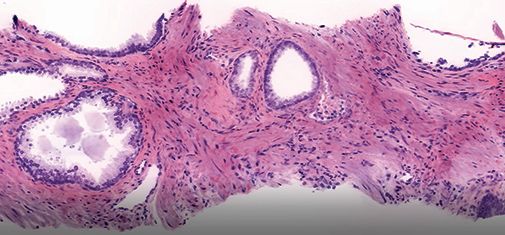
Figure 4: A two-dimensional section taken from a "movie" scanning through a prostate biopsy. The coloration nearly perfectly matches the H&E stain used in pathology. Scanning through the three-dimensional image allows an understanding of the biopsy structure (Private communication, J. Liu). For more detailed images, see their most recent publication (7).
Another recent development in LSM has been an impressive effort to miniaturize the light sheet and combine the sheet with a traditional microscope equipped with optical tweezers and cell tracking. Live cell analysis optimally involves following dynamic changes in the cell with millisecond-resolution. Alexander Rohrbach's group at the University of Freiberg in Germany incorporated a light sheet within a traditional microscope setup, in the 2 mm space between the objective lens (below the sample) and the tracking lens (above the sample). They form a Bessel (nondiffractive) beam with an axicon combined with standard optics, and use a scanning mirror and additional optics, passing the light sheet through the objective, to scan the laser in the horizontal direction between the objective and the tracking lens. Notably, the final turning mirror is only 0.12 mm diameter. The light sheet passes through the sample and is reflected back through the sample on a second pass by a micro-mirror. Fluorescence is collected through the objective lens using a dichroic mirror to separate out the excitation laser. This system can achieve an axial resolution of 0.8 µm. This work was first published in Biomedical Optics Express in 2018 (8).
Finally, Jan Huisken and colleagues at the Morgridge Institute for Research in Madison, Wisconsin, have made it a goal to make LSM portable and affordable. It was Huisken's 2004 paper that helped to popularize LSM, and subsequent papers have discussed an open version of the LSM. Their project "Flamingo," supported by the Chan Zuckerberg Foundation, intends to supply modular and configurable LSM components and systems to researchers at an affordable price. The systems they are building are intended to be portable and fit into a moderate-sized suitcase. Figure 5 illustrates a zebrafish image from the very first Flamingo system. Plans currently exist for LSM systems with illumination from the top and bottom, and with single or dual illumination and detection arms.
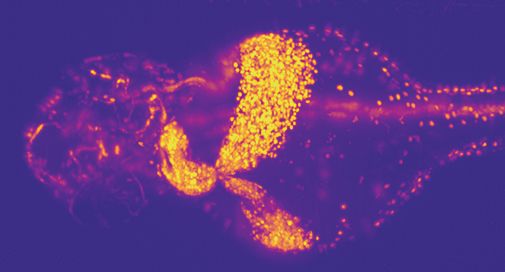
Figure 5: An image of a zebrafish from the very first Flamingo system (9).
Summary
Light sheet microscopy is evolving quickly and in many forms. From tabletop "opentop" devices to miniaturized and modular systems, LSM is moving into pathology, being combined with more traditional confocal-type systems, and becoming simpler and more modular. This mode of imaging will continue to gain in popularity as the hardware becomes increasingly developed. For spectroscopists, these are interesting developments to understand, as there are clear applications to consider, both in biology and elsewhere in planar illumination and imaging applications. A future edition of this column we will review some of the most common fluorescence methods and new techniques, including upconversion imaging.
References
(1) J. Reichmann, B. Nijmeijer, M.J. Hossain, M. Eguren, I. Schneider, A.Z. Politi, M.J. Roberti, L. Hufnagel, T. Hiiragi, and J. Ellenberg, Science 361(6398), 189–193 (2018).
(2) K. Chung, J. Wallace, S.Y. Kim, S. Kalyanasundaram, A.S. Andalman, T.J. Davidson, J.J. Mirzabekov, K.A. Zalocusky, J. Mattis, A.K. Denisin, and S. Pak, Nature 497(7449), 332–337 (2013).
(3) D. Jing, S. Zhang, W. Luo, X. Gao, Y. Men, C. Ma, X. Liu, Y. Yi, A. Bugde, B.O. Zhou, and Z. Zhao, Cell Res. 28(8), 803–818 (2018).
(4) Retrieved from https://luxendo.eu/news-events/news/2018/09/04/groundbreaking-work-published-by-embl-utilizing-a-prototype-that-led-to-the-development-of-the-invi-spim-by-luxendo/ on September 22, 2019.
(5) US Patent 6,744,572.
(6) A.K. Glaser, N.P. Reder, Y. Chen, E.F. McCarty, C. Yin, L. Wei, Y. Wang, L.D. True, and J.T. Liu, Nat. Biomed. Eng. 1(7), 0084 (2017).
(7) N.P. Reder, A.K. Glaser, E.F. McCarty, Y. Chen, L.D. True, and J.T. Liu, Arch. Pathol. Lab. Med. 143(9), 1069–1075 (2019).
(8) A.B. Kashekodi, T. Meinert, R. Michiels, and A. Rohrbach, Biomed. Opt. Express 9(9), 4263-4274 (2018).
(9) Retrieved from https://involv3d.org/gallery/ on September 27, 2019.
Steven G. Buckley, PhD,

Steven G. Buckley, PhD, is the Vice President of Product Development and Engineering at Ocean Insight, an affiliate associate professor at the University of Washington, and has started and advised numerous companies in spectroscopy and in applications of machine learning. He has approximately 40 peer-reviewed publications and 6 patents. His work in practical optical spectroscopy, such as LIBS, Raman, and TDL spectroscopy, dovetails with the coverage in this column, which reviews methods (new and old) in laser-based spectroscopy and optical sensing. Direct correspondence to: SpectroscopyEdit@mmhgroup.com
